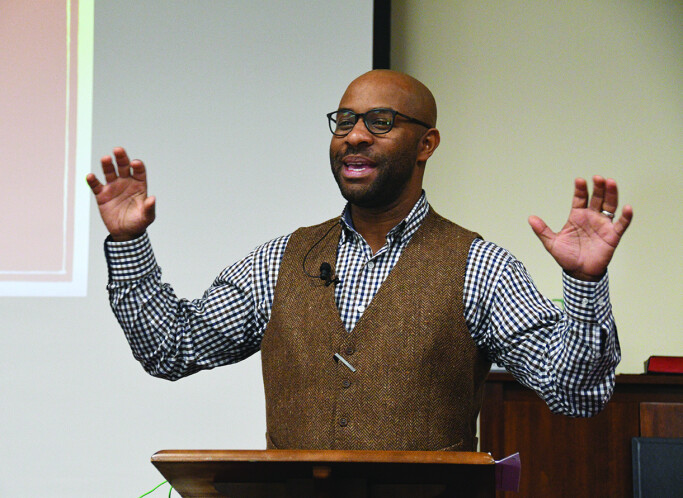Olu Brown shares leadership lessons from Moses
by Melissa Lauber

The Rev. Olu Brown speaks at the BWC Mission Center Oct. 27.
On Oct. 27, Brown led a session at the Baltimore-Washington Conference, and the next day at Jackson Chapel UMC in Frederick, to share some of his ideas about the Future of the 21st Century Church.
Currently, the story of Moses is on his mind, Brown said, particularly the sometimes overlooked passages in Numbers 32.
In this story, Gad and Reuben asked to stay in the
“The results could have been catastrophic,” Brown said. But how Moses chose to deal with this “stuff of the journey” shaped his leadership.
Even while struggling with a multitude of emotions, Moses raised his hand and blessed the Gadites and Reubenites.
How today’s “leaders and chasers of dreams and promises” navigate the details of difficult situations teaches them the most about life, themselves and God. “Leaders grow only to the threshold of their pain,” said Brown, quoting author Sam Chand.
To help leaders learn how to deal with difficult situations, and to move forward toward who God is calling them and the church to be, is one of the themes of Brown’s new book, “Leadership Directions from Moses: On the Way to a Promised Land.”
In this book, the Rev. Rodney Smothers, the Conference Director of Leadership and Congregational Development, wrote about how leaders
Smothers asserts that “balancing the ‘go’ mandate of God while navigating the doubts of followers takes not only skill but inner strength. This special type of anointed leadership requires a constant recalibrating of the purpose and plans when we are faced with an ever-changing landscape accompanied by fickle and fearful followers.”
Leaders will have tension in their lives, Brown said. “When you’re asking God for leadership, you’re asking for tension to come into your life,” he said. The greater the endeavor, the more tension you invite.
As an illustration, Brown handed out rubber bands and asked participants to stretch them. “Too much
To help people find this healthy tension, especially in times of conflict, Brown encouraged them to “trust the pause.” That moment of inaction and stillness may feel uncomfortable, he said, but it “gives you time to catch your breath, recalibrate and shift into a more positive future.”
He also stressed the need for defining and making clear the church’s vision.
“Our Bible is a footprint to help us define
To pursue the vision, leaders must be willing to risk, to learn new things, be strategic and not just spiritual, insist on excellence, and understand the lifestyle of a church or a ministry, he said.
They also must be willing to work with four capacity coaches: one to help with goals, one to address failure, one to be a mirror and share unvarnished truths, and one for encouragement.
“Coaching is an essential part of leadership,” Smothers said. “Iron sharpens iron. We must get out of our solo environments.”
Good leaders are also “catalytic evangelists,” going before to create opportunities or atmospheres to connect people with Christ, Brown said. “Jesus’ model of ministry is ‘Go!’ It has nothing to do with staying or with sitting. … Go is a command, an action, a direction. … Leaders lead. Leaders go.”

